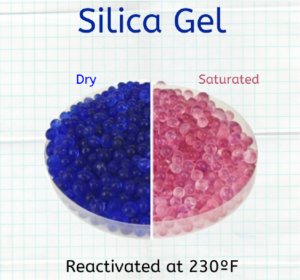When a building space or manufacturing process requires a very low moisture level in the air, a desiccant dehumidifier may be the best way to remove it. Some of you may not be familiar with the term desiccant, while others may have heard of it, but don’t know how it is used in a dehumidifier. In my three part series, I will explain the science behind desiccants, how a desiccant dehumidifier works and finally application examples where a desiccant dehumidifier is the best way to remove moisture.
What is a Desiccant?
A desiccant is a substance that can attract and hold water when used as a drying agent. The most common desiccant is silica gel, which is what is used most often in industrial desiccant dehumidifiers. Silica gel is the crystalline form of silicon dioxide (SiO2). It has a very porous structure with an interconnecting network of microscopic pores, which gives silica gel a very large surface area.
Silica gel captures water molecules by the process of adsorption. This is the process where the atoms of the water molecule adhere to the surface of the silica gel through a bonding process. The adsorption process will go on until the entire surface of the silica gel is coated with a thin film of water molecules. Because of the large surface area in silica gel, it can adsorb 40% of its weight in water.
The one property that makes silica gel so widely used as a desiccant is the fact that the adsorption process can easily be reversed. The bonds between water and silica gel can be broken at temperatures above 230ºF. Once cooled, the silica gel can then be reused to adsorb moisture.
Desiccant Dehumidifiers Part 2
Now that we have learned about the science behind desiccants, in Part 2 of this series, I’ll explain how the properties that make silica gel a great desiccant are incorporated into the design and operation of an industrial desiccant dehumidifier.
